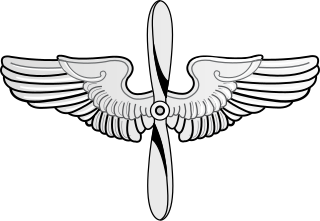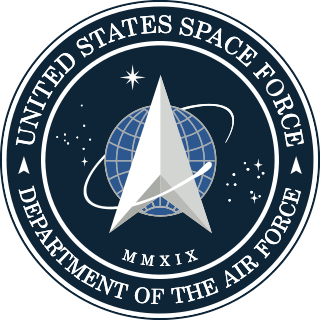Related Research Articles

The Indonesian National Armed Forces are the military forces of the Republic of Indonesia. It consists of the Army (TNI-AD), Navy (TNI-AL), and Air Force (TNI-AU). The President of Indonesia is the Supreme Commander of the Armed Forces. As of 2023, it comprises approximately 400,000 military personnel including the Indonesian Marine Corps, which is a branch of the Navy.
The United States Armed Forces are the military forces of the United States. The armed forces consist of six service branches: the Army, Marine Corps, Navy, Air Force, Space Force, and Coast Guard. All six armed services are among the eight uniformed services of the United States, along with the U.S. Public Health Service Commissioned Corps and the NOAA Commissioned Officer Corps.
Military doctrine is the expression of how military forces contribute to campaigns, major operations, battles, and engagements. A military doctrine outlines what military means should be used, how forces should be structured, where forces should be deployed, and the modes of cooperation between types of forces. "Joint doctrine" refers to the doctrines shared and aligned by multinational forces or joint service operations.

The Joint Chiefs of Staff (JCS) is the body of the most senior uniformed leaders within the United States Department of Defense, which advises the president of the United States, the secretary of defense, the Homeland Security Council and the National Security Council on military matters. The composition of the Joint Chiefs of Staff is defined by statute and consists of a chairman (CJCS), a vice chairman (VJCS), the chiefs of the Army, Marine Corps, Navy, Air Force, Space Force, and the chief of the National Guard Bureau. Each of the individual service chiefs, outside their JCS obligations, works directly under the secretaries of their respective military departments, e.g. the secretary of the Army, the secretary of the Navy, and the secretary of the Air Force.

The Goldwater–Nichols Department of Defense Reorganization Act of October 4, 1986 made the most sweeping changes to the United States Department of Defense since the department was established in the National Security Act of 1947 by reworking the command structure of the U.S. military. It increased the powers of the chairman of the Joint Chiefs of Staff and implemented some of the suggestions from the Packard Commission, commissioned by President Reagan in 1985. Among other changes, Goldwater–Nichols streamlined the military chain of command, which now runs from the president through the secretary of defense directly to combatant commanders, bypassing the service chiefs. The service chiefs were assigned to an advisory role to the president and the secretary of defense, and given the responsibility for training and equipping personnel for the unified combatant commands.
AirLand Battle was the overall conceptual framework that formed the basis of the US Army's European warfighting doctrine from 1982 into the late 1990s. AirLand Battle emphasized close coordination between land forces acting as an aggressively maneuvering defense, and air forces attacking rear-echelon forces feeding those front line enemy forces. AirLand Battle replaced 1976's "Active Defense" doctrine, and was itself replaced by "Full Spectrum Operations" in 2001.

The Global War on Terrorism Service Medal (GWOT-SM) is a military award of the United States Armed Forces which was created through Executive Order 13289 on 12 March 2003, by President George W. Bush. The medal recognizes those military service members who have supported operations to counter terrorism in the War on Terror from 11 September 2001, to a date yet to be determined.

The United States Army Space and Missile Defense Command (USASMDC) is the Army Service Component Command (ASCC) for United States Strategic Command and United States Space Command. It was established in 1985 as the Army Strategic Defense Command, responsible for ballistic missile defense. In 1992, it merged with Army Space Command to become Army Space and Strategic Defense Command. In 1997, it became an Army Major Command and was redesignated Army Space and Missile Defense Command.
NATO Joint Military Symbology is the NATO standard for military map symbols. Originally published in 1986 as Allied Procedural Publication 6 (APP-6), NATO Military Symbols for Land Based Systems, the standard has evolved over the years and is currently in its fifth version (APP-6D). The symbols are designed to enhance NATO's joint interoperability by providing a standard set of common symbols. APP-6 constituted a single system of joint military symbology for land, air, space and sea-based formations and units, which can be displayed for either automated map display systems or for manual map marking. It covers all of the joint services and can be used by them.

The Republic of China Army (ROCA), also known as the ROC Army or Chinese Army and unofficially as the Taiwanese Army, is the largest branch of the Republic of China Armed Forces. An estimated 80% of the ROC Army is located on Taiwan, while the remainder are stationed on the Penghu, Kinmen, Matsu, Dongsha, and Taiping Islands.

The Philippine Army (PA) is the main, oldest and largest branch of the Armed Forces of the Philippines (AFP), responsible for ground warfare and as of 2021 had an estimated strength of 143,100 soldiers The service branch was established on December 21, 1935, as the Philippine Commonwealth Army. The Philippine Army has engaged in many conflicts including the ongoing Communist rebellion in the Philippines, the Moro conflict and, alongside other national military forces, in conflicts of international scope.

Command and control is a "set of organizational and technical attributes and processes ... [that] employs human, physical, and information resources to solve problems and accomplish missions" to achieve the goals of an organization or enterprise, according to a 2015 definition by military scientists Marius Vassiliou, David S. Alberts, and Jonathan R. Agre. The term often refers to a military system.
The Soviet Ground Forces, successor to the Red Army, the title changing in 1945, employed a wide range of different military formations.

William Eugene DePuy was a United States Army general and the first commander of the United States Army Training and Doctrine Command. He is widely regarded as one of the principal architects of the restructuring of United States Army doctrine after the American withdrawal from Vietnam.

General Donn Albert Starry was a United States Army four-star general who served as commanding general of United States Army Training and Doctrine Command from 1977 to 1981, and as commander in chief of United States Readiness Command from 1981 to 1983.

The United States Marine Corps (USMC), also referred to as the United States Marines, is the maritime land force service branch of the United States Armed Forces responsible for conducting expeditionary and amphibious operations through combined arms, implementing its own infantry, artillery, aerial, and special operations forces. The U.S. Marine Corps is one of the eight uniformed services of the United States.

The United States Army Air Forces was the major land-based aerial warfare service component of the United States Army and de facto aerial warfare service branch of the United States during and immediately after World War II (1941–1947). It was created on 20 June 1941 as successor to the previous United States Army Air Corps and is the direct predecessor of the United States Air Force, today one of the six armed forces of the United States. The AAF was a component of the United States Army, which on 2 March 1942 was divided functionally by executive order into three autonomous forces: the Army Ground Forces, the United States Army Services of Supply, and the Army Air Forces. Each of these forces had a commanding general who reported directly to the Army Chief of Staff.

The United States Army Air Corps (USAAC) was the aerial warfare service component of the United States Army between 1926 and 1941. After World War I, as early aviation became an increasingly important part of modern warfare, a philosophical rift developed between more traditional ground-based army personnel and those who felt that aircraft were being underutilized and that air operations were being stifled for political reasons unrelated to their effectiveness. The USAAC was renamed from the earlier United States Army Air Service on 2 July 1926, and was part of the larger United States Army. The Air Corps became the United States Army Air Forces (USAAF) on 20 June 1941, giving it greater autonomy from the Army's middle-level command structure. During World War II, although not an administrative echelon, the Air Corps (AC) remained as one of the combat arms of the Army until 1947, when it was legally abolished by legislation establishing the Department of the Air Force.

The United States Space Force (USSF) is the space force branch of the United States Armed Forces and one of the eight uniformed services of the United States. It is one of two independent space forces in the world.
References
- ↑ General William R. Richardson, US Army (January–February 1997). "FM 100-5: The AirLand Battle in 1986" (PDF). Military Review: 174.
- 1 2 "FM 100-5: Tentative field service regulations operations, 1939". Archived from the original on January 29, 2023.
- ↑ "FM 100-5: field service regulations - operations, 1941". Archived from the original on January 28, 2023.
- ↑ "FM 100-5: field service regulations - operations, 1944". Archived from the original on April 2, 2023.
- ↑ Herbert, Major Paul Hardy (July 1988). "Deciding what has to be done" (PDF). Leavenworth Papers. Archived from the original (PDF) on January 28, 2023.
- 1 2 Long, Major Jeffrey W. (7 June 1991). "The Evolution of U.S. Army Doctrine: From Active Defense to AirLand Battle and Beyond" (PDF). Archived from the original (PDF) on January 28, 2023.. Master's thesis.
- ↑ Romjue, John L. (June 1984). "From Active Defense to AirLand Battle: The Development of Army Doctrine, 1973-1982" (PDF). Fort Monroe, Virginia. United States Army Training and Doctrine Command. Archived from the original (PDF) on January 28, 2023.
- ↑ FM 100-5: Operations, 1982
- ↑ "FM 100-5: Operations" (PDF). 5 May 1986. Archived from the original (PDF) on January 30, 2023.
- ↑ Blythe 2010, p. 1.
- ↑ "FM 100-5: Operations" (PDF). June 1993. Archived from the original (PDF) on January 10, 2023.
- ↑ Blythe 2010, p. 2.
- ↑ McCormick, Major Michael (22 May 1997). "The New FM 100-5: A Return to Operational Art" (PDF). United States Army Command and General Staff College. Archived from the original (PDF) on January 28, 2023.
Bibliography
- Blythe, Wilson C. (March 2010). AirLand Battle: The Development of a Doctrine (PDF) (Masters). Eastern Michigan University. Archived from the original (PDF) on January 29, 2023.